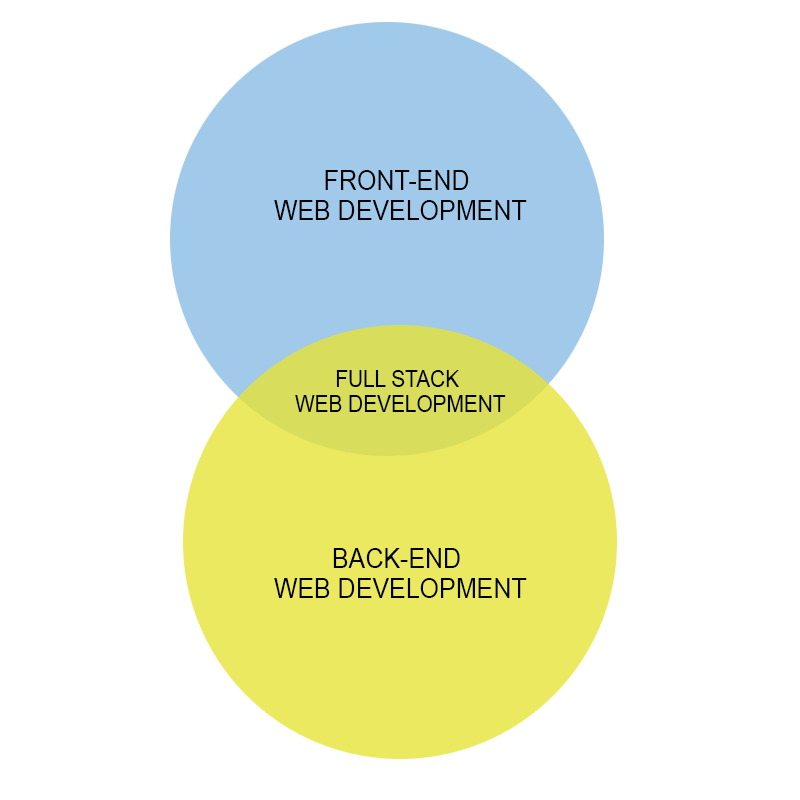Let’s say you’re a small-to-medium business owner looking to build his first website or revitalize an existing one. The question then becomes, who do you hire to help you tackle this awesome task? In Part 1 of Web Development 101, we’ll discuss the roles and responsibilities of the key members of your web development team: namely, front-end developers, back-end developers and full-stack developers.
For the purpose of this discussion we’ll assume that you already know the basics of website management. You’ve already registered a domain name, rented some server space and uploaded your website. If you’re not even at that initial stage yet, we invite you to learn more about the website basics of building your first site. Once you’ve got the basics squared away, you should be ready to launch your site. This series will review some of the key concepts and terms you’ll need to know in order to make that site launch as successful as possible.

The first step, as mentioned earlier, is knowing who to hire. Here are a few of the key figures you’ll need to make your website launch a success.
Front End Web Development
Front-end developers are primarily responsible for web design, or how the page “looks,” as well as installing user-facing coding language, or how the page “acts.” In short, they create the elements that allow users to see and interact with a website. Front-end developers rely on such web design software as Photoshop and Fireworks, as well as coding languages like HTML, CSS or JavaScript that make the site work. If one were to think of developing a website as like waging a war, the front-end developers are on the front lines of that battle. Why do we say that? Because they build the visual and technical elements–fonts, colors, drop-down menus, buttons, sliders, video and audio files, and more–that help your site prevail over the competition.
These days the main challenge facing front-end developers is building user-friendly sites that function seamlessly regardless of the device (e.g., laptop, mobile phone, etc.) used to access them. To that end, front end web development is focused on creating customized, responsible web designs. These sorts of sites allow for easy site navigation with a minimum of resizing, panning or scrolling issues. This challenge becomes more pressing once you consider how frequently users turn to their handheld devices when they want to look for a website. Therefore, the front-end developer has to create a site that is both readable and adaptable.
Back End Web Development
While front-end developers work on the parts of the website you as the user gets to see, back-end developers are doing the behind-the-scenes work that makes the site function. Whether you’re looking to create a login account or make an online purchase, back-end development is the process that makes it possible. How do they accomplish what seems like the layman to be impossible? They do it by writing the scripting language that enables a site to follow the user’s commands. The scripts back-end developers create is open source, meaning that users can view and edit the script code if necessary. Examples of commonly used scripting programs and applications include PHP, Ruby and Python.
In recent years sharp divisions have been made between front-end and back-end developers. It can even seem that sometimes the two groups are in opposition with one another. In truth, however, both must act in concert with one another to create a website. Using the war analogy from earlier, back-end developers are the grunts in the trenches of website development. Writing clean, consistent code without any “breaks” can be arduous, unglamorous work. Without their efforts, however, a site simply wouldn’t function. Also, resources like WordPress prove that front-end and back-end developers need each other. Such a resource couldn’t work without either element–the open-source PHP coding on the back end or the server functionality on the front end–in place. In fact, WordPress serves as a good example of how distinctions between the job responsibilities of front-end and back-end web development have become blurred.
Full Stack Web Development
If front-end development and back-end development sometimes seems like two sides of the same army in the war to make your website work, full stack development is where both come together in peace. The responsibilities of the full-stack developer blends those of both the front-end and back-end developer (as mentioned above). Full-stack developers are versatile enough to work in either the front end or the back end of a site, meaning that they’re as comfortable working on designing websites as they are on writing open-source code. Of course, some specialization is bound to happen as developers will have their individual strengths and preferences. Hiring a full-stack developer may give you a jack of all trades but a master of none. Therefore, you’ll want to also hire front-end and back-end specialists who can help your website live up to its full potential.
Still need more information on web developers? We refer you to a few additional resources that go into further about the differences between front-end developers vs. back-end developers. And be sure to return to the Networtech blog for more Web Development 101 lessons!